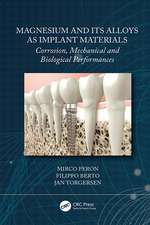Clinical Surveillance: The Actionable Benefits of Objective Medical Device Data for Critical Decision-Making: HIMSS Book Series
Autor John Zaleskien Limba Engleză Paperback – 6 noi 2020
The capture and use of these data to support clinical workflows have been written about and thoroughly debated. Yet, the use of these data for clinical guidance has been the subject of various papers published in respected medical journals, but without a coherent focus on the general subject of the clinically actionable benefits of objective medical device data for clinical decision-making purposes. Hence, the uniqueness of this book is in providing a single point-of-capture for the targeted clinical benefits of medical device data--both electronic- health-record-based and real-time--for improved clinical decision-making at the point of care, and for the use of these data to address and assess specific types of clinical surveillance.
Clinical Surveillance: The Actionable Benefits of Objective Medical Device Data for Crucial Decision-Making focuses on the use of objective, continuously collected medical device data for the purpose of identifying patient deterioration, with a primary focus on those data normally obtained from both the higher-acuity care settings in intensive care units and the lower-acuity settings of general care wards. It includes examples of conditions that demonstrate earlier signs of deterioration including systemic inflammatory response syndrome, opioid-induced respiratory depression, shock induced by systemic failure, and more. The book provides education on how to use these data, such as for clinical interventions, in order to identify examples of how to guide care using automated durable medical device data from higher- and lower-acuity care settings. The book also includes real-world examples of applications that are of high value to clinical end-users and health systems.
| Toate formatele și edițiile | Preț | Express |
|---|---|---|
| Paperback (1) | 388.34 lei 43-57 zile | |
| Taylor & Francis – 6 noi 2020 | 388.34 lei 43-57 zile | |
| Hardback (1) | 1047.10 lei 43-57 zile | |
| Taylor & Francis – 6 noi 2020 | 1047.10 lei 43-57 zile |
Din seria HIMSS Book Series
-
 Preț: 369.54 lei
Preț: 369.54 lei - 20%
 Preț: 1009.59 lei
Preț: 1009.59 lei -
 Preț: 259.76 lei
Preț: 259.76 lei - 8%
 Preț: 486.70 lei
Preț: 486.70 lei - 20%
 Preț: 265.82 lei
Preț: 265.82 lei -
 Preț: 389.59 lei
Preț: 389.59 lei - 5%
 Preț: 248.38 lei
Preț: 248.38 lei - 20%
 Preț: 457.61 lei
Preț: 457.61 lei -
 Preț: 366.52 lei
Preț: 366.52 lei - 5%
 Preț: 373.22 lei
Preț: 373.22 lei - 23%
 Preț: 399.72 lei
Preț: 399.72 lei - 5%
 Preț: 401.65 lei
Preț: 401.65 lei - 18%
 Preț: 911.44 lei
Preț: 911.44 lei - 23%
 Preț: 379.22 lei
Preț: 379.22 lei - 9%
 Preț: 936.25 lei
Preț: 936.25 lei - 25%
 Preț: 600.46 lei
Preț: 600.46 lei -
 Preț: 460.09 lei
Preț: 460.09 lei - 5%
 Preț: 372.50 lei
Preț: 372.50 lei - 22%
 Preț: 370.02 lei
Preț: 370.02 lei - 15%
 Preț: 490.17 lei
Preț: 490.17 lei - 15%
 Preț: 460.53 lei
Preț: 460.53 lei - 15%
 Preț: 495.19 lei
Preț: 495.19 lei - 31%
 Preț: 391.92 lei
Preț: 391.92 lei - 22%
 Preț: 387.99 lei
Preț: 387.99 lei - 26%
 Preț: 764.20 lei
Preț: 764.20 lei - 15%
 Preț: 558.47 lei
Preț: 558.47 lei - 31%
 Preț: 284.92 lei
Preț: 284.92 lei - 31%
 Preț: 286.90 lei
Preț: 286.90 lei - 17%
 Preț: 380.35 lei
Preț: 380.35 lei - 31%
 Preț: 466.73 lei
Preț: 466.73 lei - 15%
 Preț: 653.71 lei
Preț: 653.71 lei - 12%
 Preț: 343.55 lei
Preț: 343.55 lei - 31%
 Preț: 428.51 lei
Preț: 428.51 lei - 12%
 Preț: 343.55 lei
Preț: 343.55 lei - 18%
 Preț: 844.73 lei
Preț: 844.73 lei - 31%
 Preț: 467.44 lei
Preț: 467.44 lei -
 Preț: 466.45 lei
Preț: 466.45 lei - 29%
 Preț: 348.33 lei
Preț: 348.33 lei
Preț: 388.34 lei
Preț vechi: 485.43 lei
-20% Nou
Puncte Express: 583
Preț estimativ în valută:
74.31€ • 77.79$ • 61.49£
74.31€ • 77.79$ • 61.49£
Carte tipărită la comandă
Livrare economică 07-21 aprilie
Preluare comenzi: 021 569.72.76
Specificații
ISBN-13: 9780367369309
ISBN-10: 0367369303
Pagini: 192
Ilustrații: 52 Line drawings, black and white; 24 Tables, black and white; 76 Illustrations, black and white
Dimensiuni: 178 x 254 x 10 mm
Greutate: 0.86 kg
Ediția:1
Editura: Taylor & Francis
Colecția Productivity Press
Seria HIMSS Book Series
Locul publicării:Oxford, United Kingdom
ISBN-10: 0367369303
Pagini: 192
Ilustrații: 52 Line drawings, black and white; 24 Tables, black and white; 76 Illustrations, black and white
Dimensiuni: 178 x 254 x 10 mm
Greutate: 0.86 kg
Ediția:1
Editura: Taylor & Francis
Colecția Productivity Press
Seria HIMSS Book Series
Locul publicării:Oxford, United Kingdom
Public țintă
Professional Practice & DevelopmentCuprins
1. Introduction to Clinical Surveillance 2. Use of Patient Care Device Data for Clinical Surveillance 3. Alarms and Clinical Surveillance 4. Mathematical Techniques Applied to Clinical Surveillance 5. Clinical Workflows Supported by Patient Care Device Data
Notă biografică
John Zaleski is Head of Clinical Informatics at Capsule Tech, Inc. John Zaleski brings 25+ years of experience in healthcare and medical device data principally as a researcher and, later, as a clinician, to improve the safety and care of patients and clinicians.
Descriere
For more than a decade, the focus on information technology has been on capturing and sharing data from the patient within an all-encompassing record, to promote improved longitudinal oversight in the care of the patient. A key element to improved patient care has been the automated capture of data from durable medical devices.


























